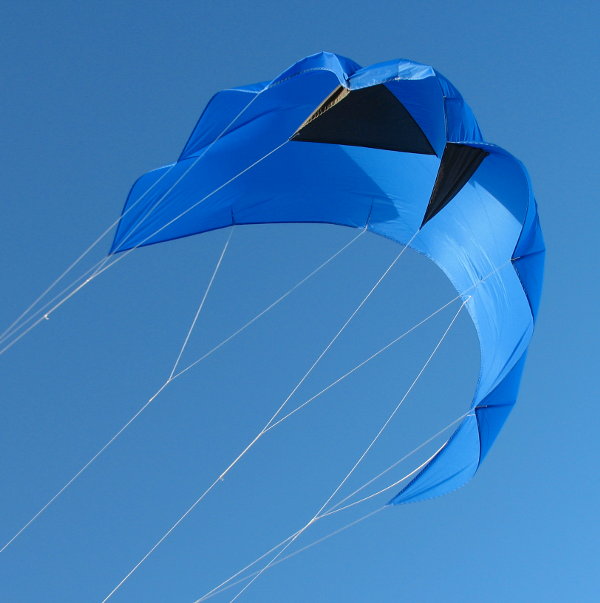
Rata Jet is a single skin kite descending from NASA parawing (NPW) line. This design attempts to increase single skin kite performance by delaying the point at which nose collapse occurs. This is done by using a RATA (rib angled to airflow) to slow airflow and increase pressure under the nose area.
- Flat aspect ratio: 4.2 (using the w2/a formula)
- Area: 1.5 m2
- Tip to Tip: 2.5 m
- Center chord: 1.0 m
Design
Below is the plan for this kite. The small square boxes indicate canopy bridle attachment points. Three dimensional sail shape is controlled by notches in the canopy. The notches in the nose of the kite are in the canopy, not the RATA ribs. The RATA ribs are sewn flat to the kite along the curved line. Unfolding these produces a three dimensional shape in the canopy. Scaling this plan by [grid line = 50cm] gives the specifications listed in the first section.One "design leap" in this model is the reduced number of LE bridle attachment points in comparison with a standard NPW design. Both notches and increased fabric (described further below) are used in an attempt to reduce the canopy folds which occur at high point loads.
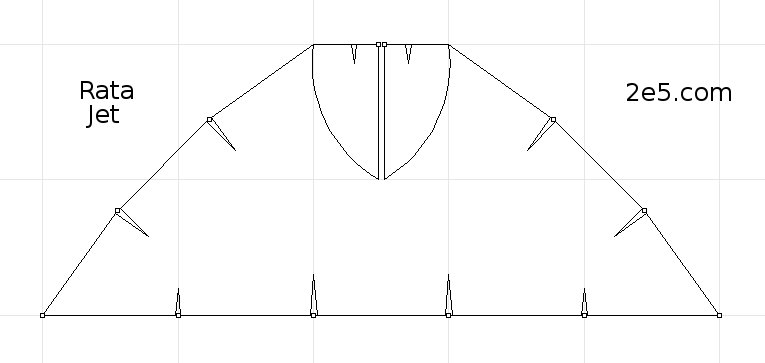
CAD code for producing this drawing follow. The points for the notches on the leading edges lie on the circle centered at (5,-3).
; Rata Jet v.1, 2008, Bill Ola Rasmussen
; bridle points
_points 0,0 0.552941,0.771427 1.22857,1.44706 1,0 2,0 2.48,2 _enter
; LE and notches
_lines 2.5,0 0,0 0.538737,0.751589 0.780057,0.578816 0.570193,0.78868
1.21132,1.42981 1.42118,1.21994 1.24841,1.46126 2,2 _enter
; nose
_line 2,2 2.5,2
; rata trim line
_line 2,1 2.5,1
; rata sew curve
_circle _3point 2,2 2.48,1 4,2
; (manual step: trim circle to arc between nose and rata trim line)
; bottom of rata
_line 2.48,1 2.48,2
; nose notches
_lines 2.28,2 2.3,1.86 2.32,2 _enter
; TE notches
_lines 0.98,0 1,0.2 1.02,0 _enter
_lines 1.975,0 2,0.3 2.025,0 _enter
; (manual step: reflect around x=2.5)
Two manual steps are indicated in order to keep the code brief.
Differences between this and the original RATA model:
- Fewer RATA's: The most critical area to support is the nose of the kite. If it starts folding, performance degrades quickly. Each RATA does contribute to drag, so this current iteration reduces RATA's to the minimum.
- Lower AR: not necessarily a design goal in itself, but it is easier to tune a lower AR kite. Once other parameters are optimized, a higher AR can be tried.
- Notches: Since some bridle lines are not connected directly to RATA's, we no longer have have a built in load curtain to distribute the bridle forces. Notches pull in material from the sides so that point loads are less likely to induce a fold in the fabric.
- LE bulge: Also a workaround for not having the RATA load curtain aspect. This also makes more material available in the direction of load in an attempt to reduce the point load folding.
- TE control lines: Less force is needed in the tips for turning if some of the canopy load is taken by the rear lines attached to the TE.
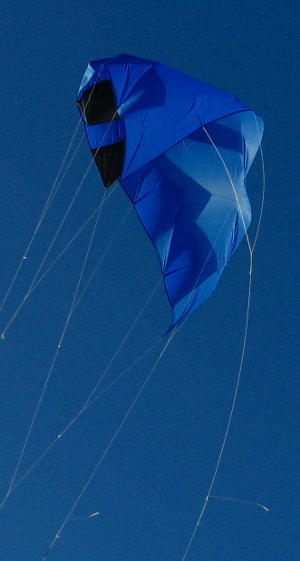
Analysis
Looking at the pictures on this page, there are at least three things to note:- Nose: The first picture on this page shows a front view. In addition to the nose area, the sections just to the left and right of the RATA's seem especially prone to folding. Possible culprits are the RATA's adjacent to each of these areas, and the bridle setting near the nose.
- Canopy folds: Seen just to the right, note the two folds leading away from the bridle to canopy attachment points. These are not traveling along the notch fold, but rather into the canopy on a path parallel to the TE. There does not appear to be any appreciable folding at the TE bridle connections.
- Tips: Just to the right the tip extremities seem to have a very high AOA. Below, this angle looks more normal. Note how the notches just before the tips on both the LE and TE absorb enough material so that the tip fold barely appears.
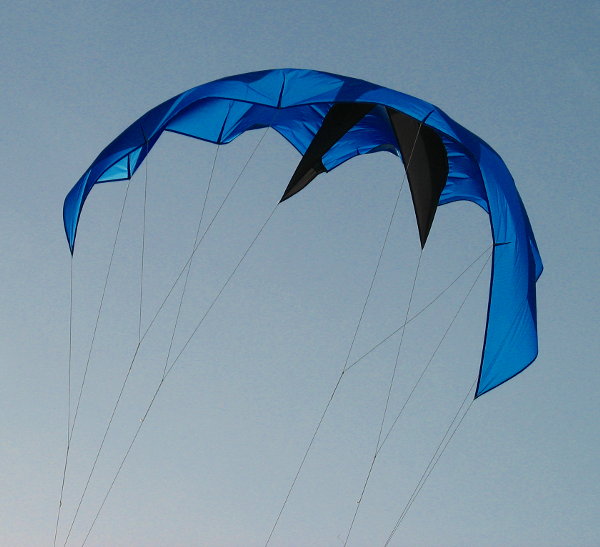
The above tail view shows the bridling of the kite. Cascaded primaries and secondaries are used for the LE, and just primaries for the TE. Bridle adjustment is done by Prusik knot, as shown on the NPWC 2 Line Bridle page.
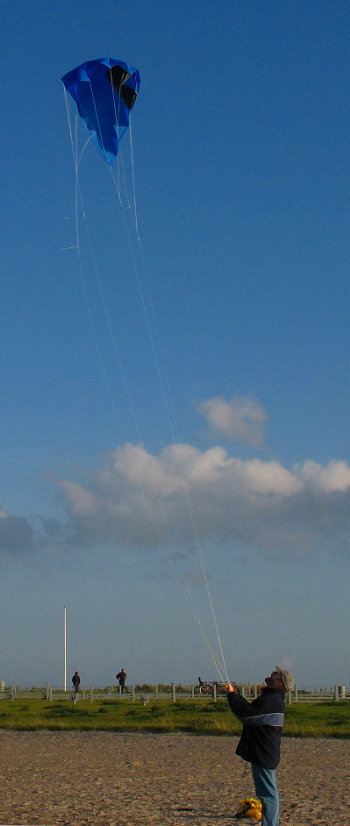
Performance
To the right we see Rata Jet flying quite high up in the window. From the angle of the flying lines, LD appears to be greater than 4! Ok, it looks really nice and is what we are aiming for, but normal flight aspects are not so rosy. At times, the performance of this kite is brilliant. The next moment, an edge will fold and the kite will slide back down in the window.See a a video of single line flight. It's a 17mb download. A smaller, lower quality version of the video is available on YouTube. Mid video, near apogee, you can see the nose and leading edges folding and unfolding. This indicates that the airflow is switching between splitting just above and just below the leading edge. I believe maximum performance is to be had at a bridle setting where the airflow splits just under the leading edge.
More bridle tuning may be able to fix this spotty behavior. If you also want to work on this, email me and I will give you the latest bridle measurements. Canopy plans are included on this page.
Possible improvements for the next iteration:
- RATA design: Nose fold may be due to the RATA itself operating at too low an AOA. This can be fixed by lengthening the front leg and/or shortening the back leg.
- Notch orientation: Even with the notches, folding appears at the bridle canopy interface. I think that this can be at least partially mitigated by orienting the notches in line with the folds. I.e. instead of running the LE notches following the angle of LE segment intersection, run them horizontally (parallel to the TE).
- Should something be done about the tips? In some pictures they look good, but in others, they appear to be operating at too high an AOA. I have see some single skin designs where the tips are clipped off at an angle. This might be worth trying.
Rata Jet is a design which gives glimpses of brilliant performance and deserves further development.
Related pages:
Rata Wing Kite
Lift to Drag Ratio